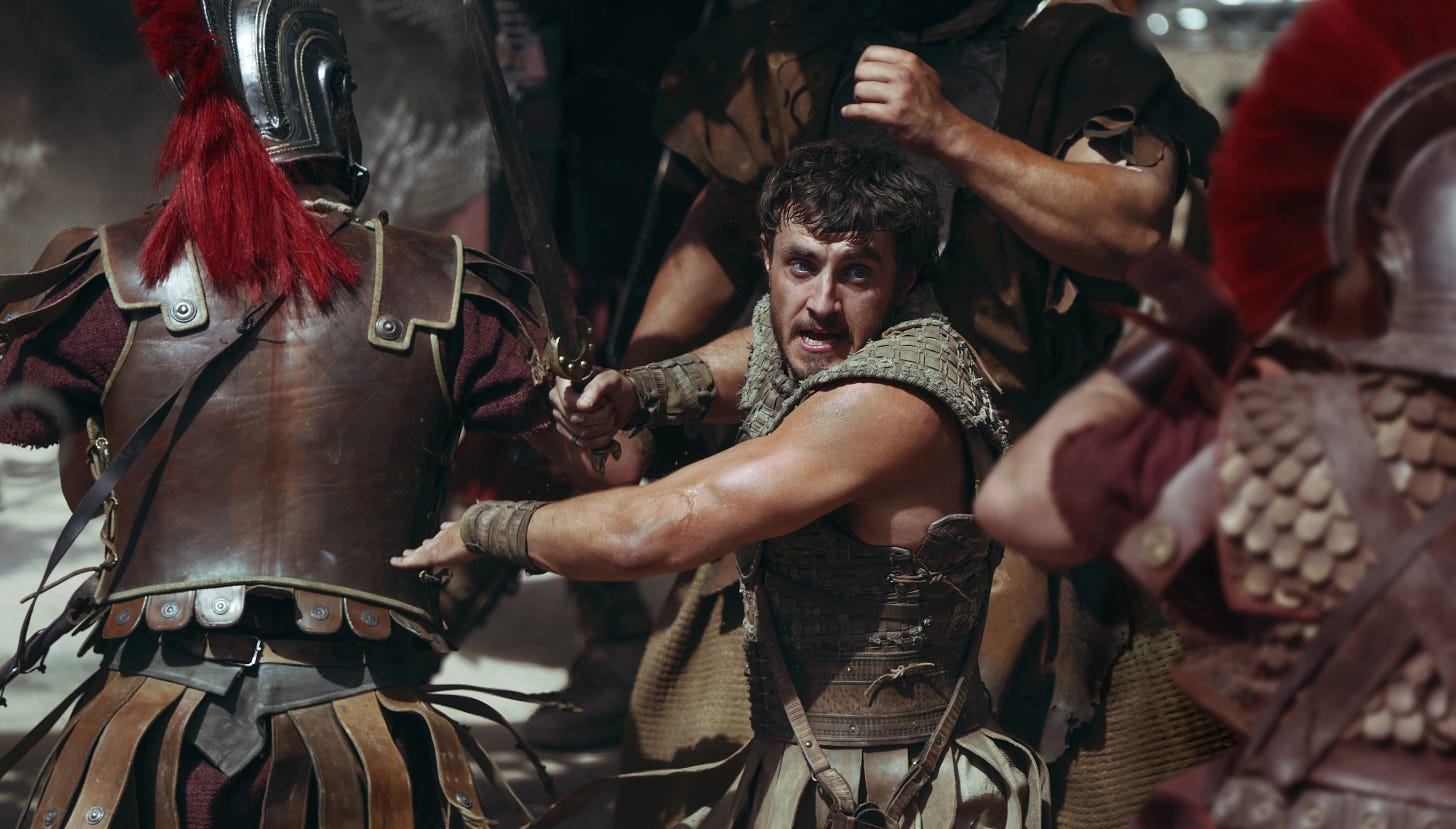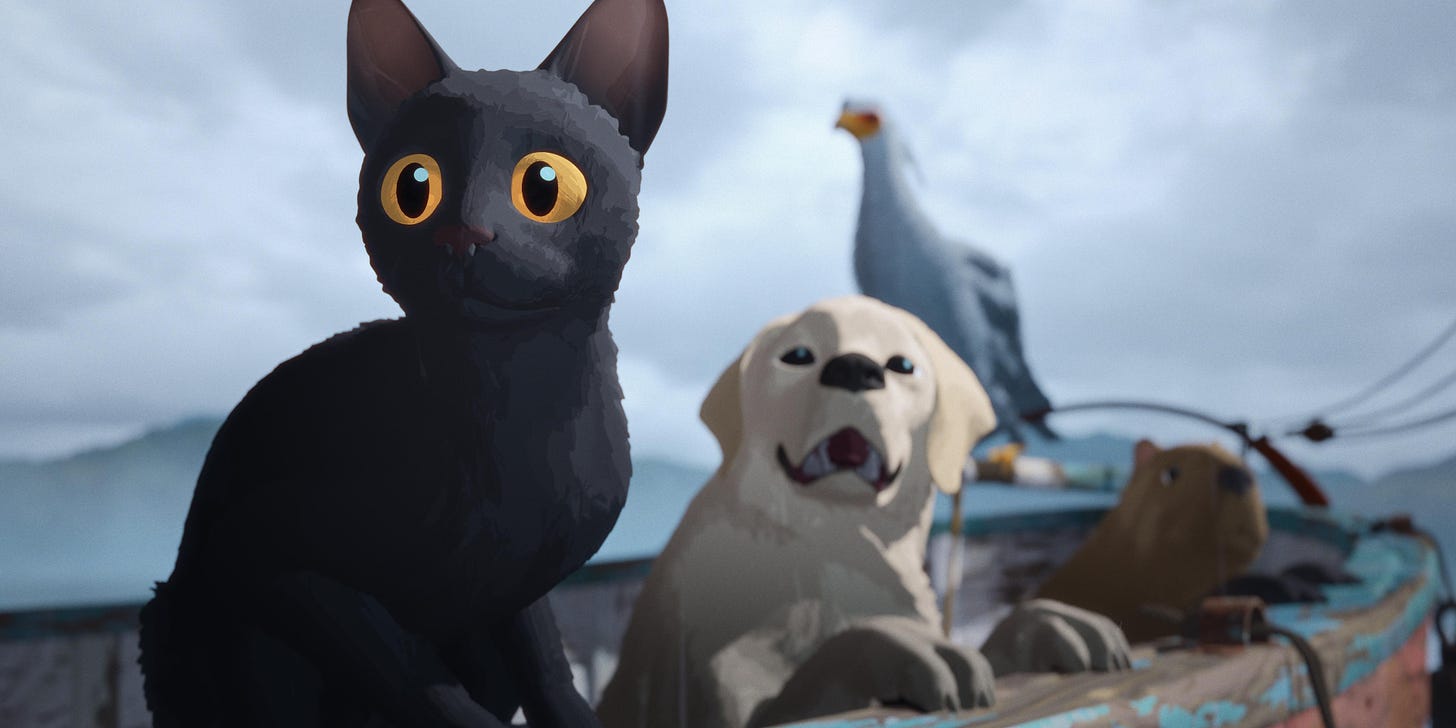In Review: 'Gladiator II,' 'Flow'
A week of nothing but reviews concludes with looks at Ridley Scott's 'Gladiator' sequel and a scrappy animated feature from Latvia.
Gladiator II
Dir. Ridley Scott
148 min.
Ridley Scott is one of the most distinctive directors of the past half-century and one of the least reliable. Scott’s filmography includes a small handful of masterpieces and more than a handful of worthwhile, rewarding films. There’s no obvious arc to the quality of his work. The Last Duel, one of two films the octogenarian auteur released in 2021, belongs in any discussion of his best efforts, for instance. Yet for nearly every thematically rich film in Scott’s filmography, there’s a lumbering behemoth that’s long on striking visuals and short on ideas or memorable scenes. Sometimes you get The Martian. Other times you get Exodus: Gods and Kings.
Gladiator II, a sequel to Scott’s Best Picture-winning 2000 film Gladiator, has a sprinkling of memorable scenes—it’s tough to forget gladiators doing battle with enraged gibbons—but falls squarely on the lumbering side of Scott’s work. Lacking the novelty of the original film, a throwback to historical epics of old given a modern blockbuster packaging, and absent a hero as compelling as Russell Crowe’s Maximus, the sequel’s sole reason to exist can be found in the title. Remember Gladiator? This is Gladiator, too.
Paul Mescal (excellent elsewhere but mostly filling space here) stars as Lucius, a resident of the North African province of Numidia and, as the son of Maximus and Lucilla (Connie Nielsen), the daughter of Marcus Aurelius, the true heir to Rome’s leadership. (Sent into hiding as a boy, he doesn’t like to talk about that.) After being widowed in the film’s opening sequence by soldiers under the reluctant command of Marcus Acacius (Pedro Pascal), a general who’s grown weary of war who’s married Lucilla during Lucius’ absence, Lucius is taken prisoner and removed to Rome. Following in his father’s sandalsteps, Lucius finds himself forced to fight as a gladiator, a career opportunity that unexpectedly puts him in position to reshape Rome’s leadership.
If that sounds familiar, this should, too: the film’s most flavorful contributions come from the supporting characters. Just as Joaquin Phoenix livened up the original film, Denzel Washington delivers a charged performance as Macrinus, a former gladiator who’s purchased his freedom and now runs his own stable of fighters with a pitiless pragmatism. Washington brings a cheerful wickedness to the performance that’s complicated by the revelation that Macrinus has an agenda of his own. He’s a villain, sure, but he has his reasons. Similarly, Joseph Quinn and Fred Hechinger have a good time as, respectively, Geta and Caracalla, a pair of debauched, knuckleheaded siblings serving as co-emperors.
Everything else plays like filler between fight scenes, all of which Scott directs with the expected intensity (even those without gibbons). It’s involving enough, but if the original Gladiator, however entertaining, already ranks as one of the slightest Best Picture winners in Oscars history, it looks as weighty as The Deer Hunter and Ordinary People combined next to its offspring. As many Roman emperors discovered, it’s hard to produce an heir fit to carry on your legacy. —Keith Phipps
Gladiator II opens tonight in theaters everywhere.
Flow
Dir. Gints Zilbalodis
86 min.
A few years ago, BlueTwelve Studio and Annapurna Interactive released a short yet gorgeous and immensely appealing video game called Stray, in which you play a resourceful cat fighting for survival in a post-apocalyptic urban landscape populated only by robots and mutant bacteria. There are puzzles to solve and “Zurks” to destroy, but there are silences, too, and pleasing opportunities to meow, nuzzle, and curl up for a nap—if this dystopia had bodegas, no doubt you could peer out from behind a cereal box if you’d like. That absence of frantic activity, a feature of so much media about the adventures of anthropomorphic animals, has a soothing, gentle quality to it that allows you to immerse yourself in a world you might be too busy to appreciate.
There are examples of that magisterial wordlessness towards the beginning of animated features of WALL-E and the recent The Wild Robot, but the experimental Latvian film Flow has no dialogue and that makes all the difference. Director Gints Zilbalodis brings a scrawny, wary yet intrepid cat together with a ragtag group of forest creatures for an optimistic (if dark) story of animals finding solidarity during a crisis. And while there’s plenty of behavior that seems conspicuously human-like in this Zilbalodis’ haunting, cataclysmic world, the film is nonetheless graced by the quiet poetry of sound and image, which reveals what’s possible when the chitter-chatter of celebrity voices has been cut away.
The animation takes some getting used to, because the animal renderings are as crude as the earliest days of CGI—without detailed fur, they look more like butter sculptures than big-budget films post-Monsters Inc.—but the backdrops are often photorealistic. Zilbalodis keeps his camera active and impressionistic as he follows the Cat through a world where some unspecified event has wiped out the human population, leaving odd sculptures and totems, along with an empty house where it can sleep in an unoccupied bed. After fleeing from a pack of dogs, the Cat is suddenly overwhelmed by stampeding deer who themselves are fleeing the much more imposing threat of a massive flood. Eventually, the Cat improvises its way onto a boat, where other survivors have gathered, including an ingratiating Labrador, a lemur guarding a basket of trinkets, a listless capybara, and a secretary bird that’s separated from its flock.
The Biblical levels of flooding that seem to be wiping out the remainder of the living population suggest a Noah’s Ark situation, but the Cat and his newfound companions are not paired up and are more concerned with present dangers than whatever the future might hold for them. There’s a demo-reel quality to Flow in that Zilbalodis cares more about composing striking images and individual sequences that making any kind of statement other than affirming the power of makeshift communities. The title Flow may refer to the water that whooshes these characters along, but it also suggests the style and tone of a film that’s primarily experiential and content to leave the mysteries of its world unsolved. As a viewer, you’re best advised just to go with the… well, you know. — Scott Tobias
Flow opens this weekend in limited release.









I have an issue with Gladiator that must just be a personal thing with me, because I don’t see others complaining about it: the fight scenes are poorly choreographed and shot. Closeups of a guy swinging a sword, no sense of the larger action, lots of quick cuts to another shot that doesn’t give you any real perspective. One of the best parts of a pulpy gladiator film should be the fights, and they kind of suck.
But yes, a perfectly fine movie that shouldn’t get anywhere near a Best Picture win.
Someone (maybe one of you) once wrote that there are two kinds of sequels: Rocky II, which is remake of Rocky I with more crowd-pleasing ending, and Godfather Part II, which expand and give depth to world of original film by continuing story instead of rehashing it.
Gladiator II is first kind of movie that seem like it trying to pass self off as second kind.